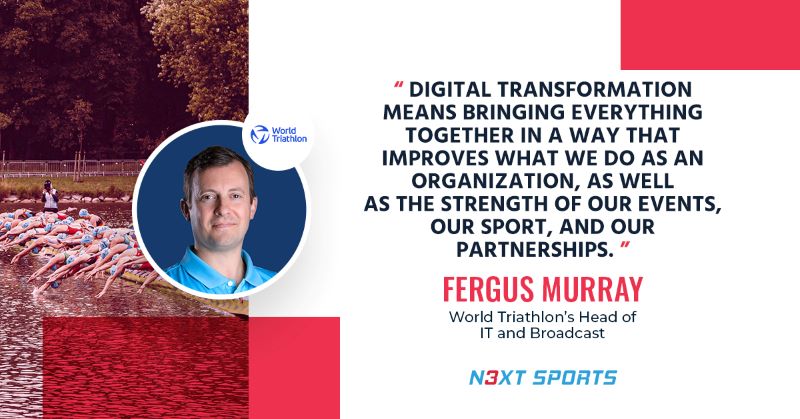Insights from Hisham Shehabi and Lara Ammar


At the heart of a sports organization’s digital transformation, understanding one’s data maturity and how performance, operational, and consumer data are connected cross-departmentally is a fundamental learning. Data, in all its forms, is the glue that combines a sports entity’s digital footprint; an imperative tool for defining the user journey and informing business development.
Nevertheless, disparities in data ownership and its accessibility across the wider organization can cause its own problems. Data complexity can be damaging to operational efficiency and the bottom-line whereby an organization’s digital framework is set up in a way that creates data silos and a disconnect between departments.
To overcome this, several sports organizations are undergoing a digital makeover which requires an upgrade to their new and existing customer-facing touchpoints and restructuring how they leverage user data. Behind every upgrade, data migration is necessary to ensure that the organization’s digital products help to optimize its data-collection capability and ensure that data silos or duplications of data sources are not created throughout the process.
“Data migration is the task of transferring data to a location and structure that makes it accessible for other digital products and workflows,” explains Hisham Shehabi, Chief Operating Officer (COO) at N3XT Sports. “This is a continuous process, meaning that, even when a data migration to a new server or platform is completed, the cleaning and management of data does not stop there.
“Once all data sources have been integrated into the new setup, a sports organization is tasked with managing the conversion of data into intelligence. Organizations that take this step are also in a better position to leverage artificial intelligence (AI) tools in the future.”
By way of example, N3XT Sports was charged by World Triathlon, the governing body for the multi-sport disciplines of triathlon, duathlon, and aquathlon, to lead the design and development of a new web platform and involved adapting its data architecture so that all existing data and future data is easily accessible within the new web platform.
As part of its digital transformation, the project will serve the federation on several fronts, including how World Triathlon leverages its diverse digital portfolio to increase awareness for its major events and sponsors, while creating a community which embodies the “triathlon lifestyle” and its disciplines, and draws on centralized fan, athlete, and stakeholder data to drive its direct-to-consumer (D2C) strategy and commercial growth, as cited in our Olympic Digital Transformation Report 2023.
Fergus Murray, World Triathlon’s Head of IT and Broadcast, says that their “sponsors want to engage further with fans” and via different avenues outside their traditional event activations. This means “working with our partners to learn how to grow engagement”, Murray adds – starting with the federation’s ability to tailor content to its fans.
“For us, digital transformation means bringing everything together in a way that improves what we do as an organization, as well as the strength of our events, our sport, and our partnerships,” Murray continues. “Part of that journey is to collate data from our different digital touchpoints, so as to better understand the fans, our athletes, and stakeholders, and how we can serve them. As part of that process, it’s also about how we can add extra value to our sponsors so that, when we engage our fans, we are able to bring them along the user journey, too, based on the fan’s interests.”
USER-DATA CENTRALIZATION A KEY STEP TOWARDS OPTIMIZING THE FAN FUNNEL
There are several challenges when establishing a digital strategy that advocates first-party data collection and ownership. Technology inside sports organizations is often additive, not complementary, meaning that technological adoption has led entities, over the years, to develop bulky, disconnected legacy systems with little thought to how the organization wants to interact with its fans, athletes, and stakeholders in the future, nor how they ingest user information.
As the sports industry looks to reconfigure its operational systems, rights holders and sports organizations are learning how dataflow serves its workforce outside its IT and marketing departments and to understand the value of first-party data across the entire business and how they can then prioritize data collection within its third-party supplier contracts. The technology sector is adapting to meet demand among sports organizations for data ownership. However, there are some governing bodies and federations that don’t align data ownership with their business objectives.
“It’s a balance, but increasingly sports organizations should be prioritizing how they grow their own first-party data and how it optimizes the fan funnel – to understand what’s valuable and what’s not valuable when it comes to fan engagement,” Hisham says. “As part of our work with our clients, change management is an important step towards increasing the digital and data literacy in an organization, to make people aware of how their data could be useful to other colleagues. It’s important to tie any data strategy to their collective corporate objectives.”
N3XT Sports has developed a high-level strategy for data migration that can be customized to each of our clients’ needs and to help them meet their business objectives. Our dedicated Project Excellence Department (PED) helps our clients to prioritize their list of objectives and to create a clear roadmap to phase out the data migration process and achieve a centralized data access within a “single source of truth”.
“When moving from an outdated to a new website, for example, migrating data from one content management system (CMS) to another requires a detailed plan to define what content you are migrating, what the strategy should be and what roles and responsibilities are being defined,” explains Lara Ammar, Project Management Office (PMO) Director at N3XT Sports. “This includes everything from the articles that are available on any given site, as well as the types of media being published, including press releases, and of course photo and video content.
“Employee education and onboarding is a vital component for helping the workforce understand the value of digital adoption, so it’s important to guide them on what’s needed from their side when creating content, or adding specific tags to an article, so as to optimize the use of data. The advice we give to all our clients is not to try to integrate everything from day one and to prioritize their approach to digital-service integration to heighten their ability to capture user data effectively, without causing a disconnect. A planned data migration and centralization is a key step to achieving this.”
WHAT’S N3XT?
Optimizing the use of fan data, in particular, is serving the sports organization’s understanding of the fan journey and the digital platforms and social media channels which drive fan engagement. Our research shows a correlation between a sports organization’s data maturity and social presence, which highlights a link between the ability to collect fan data and create content to drive audience growth and retention.
When expanding one’s digital offering, it is important to understand how this serves the business objectives across different departments and the role of data management for meeting those goals collectively. As part of our service offering at N3XT Sports, data migration is a fundamental piece within a sports organization’s digital transformation, no matter what that entails. By giving our clients the platform to consolidate information, data migration in the first instance helps optimize one’s existing digital portfolio and lays the groundwork for further digitalization.
Our team at N3XT Sports works tirelessly to develop and implement data and digital transformation strategies across a multitude of sports properties at federation level, competition level, and club level. To find out more about how N3XT Sports can serve your organization, fill out the form below, and we’ll be in touch. Our goal is to drive the digitalization of the sports industry and our clients.




